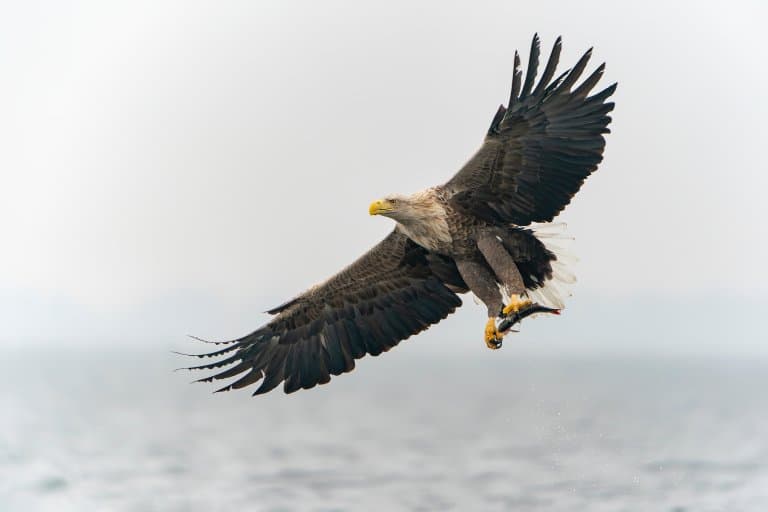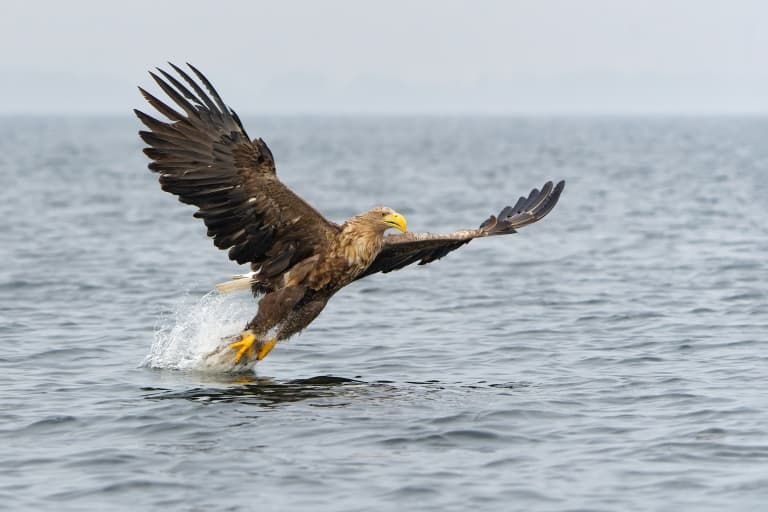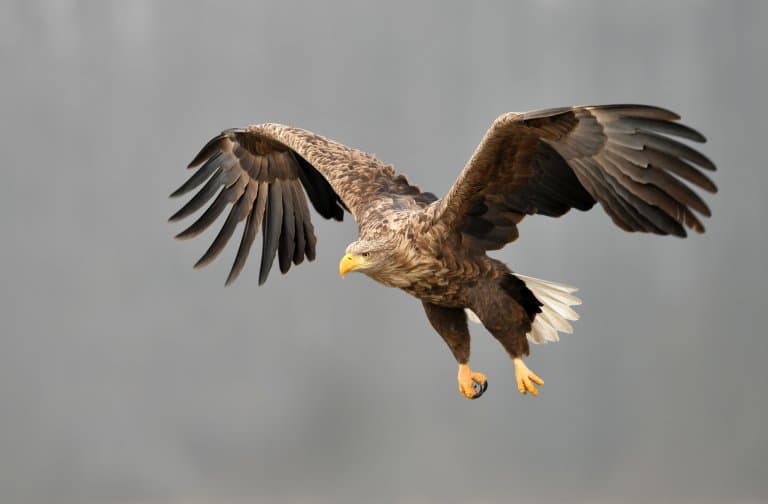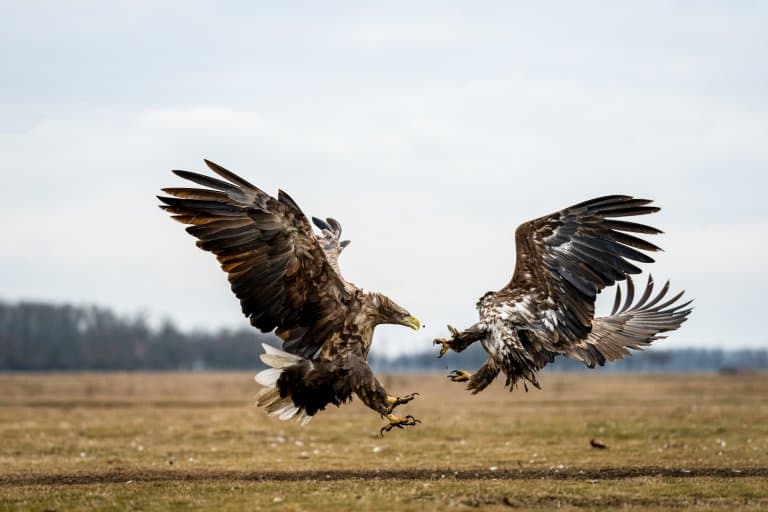White-Tailed Eagle Profile
Almost everything’s bigger in America. The clothing, the bison, the moose, the servings, the cars, and the political hysteria are just a handful of things that America has more of than their European counterparts.
But perhaps ironically, the national bird of the US, the bald eagle, has a European relative that nudges it out of contention. The white-tailed eagle, or sea eagle, is a highly successful and enormous raptor that can hold its own against any found in the Americas.

White-Tailed Eagle Facts Overview
| Habitat: | Forest, Grassland, Wetlands, Marine |
| Location: | Widespread across Eurasia, Greenland to Japan |
| Lifespan: | Over 40 years in captivity, around 20 in the wild. |
| Size: | U to 92cm (36 inches) long with a 2.4m (96 inch) wingspan |
| Weight: | Up to 7kg (15.4lb) |
| Colour: | Black and grey with a vivid white tail in maturity |
| Diet: | Generalist predators, mainly fish but also water birds, mammals |
| Predators: | None |
| Top Speed: | 70km/h |
| No. of Species: | 1 |
| Conservation Status: | Least Concern (IUCN) |
White-tailed eagles are the world’s 4th largest raptor. They are opportunistic and generalist predators, giving them an important role in population control over a number of small animal species.
Like the bald eagle, they sit at the top of the food chain and occupy an almost identical niche. In fact, the two are closely related, each lording over its own domain in isolation of one another.
White-tailed eagles live near open water, along coastlines, lakes, wetlands or rivers and nest in cliffs or high in tree-tops. They primarily feed on fish, and have the scary hardware to prove it.
And while they’ve been wiped out by ignorant practices and poisoned by any number of humanity’s environmental destructions, they’re a hardy species and have proven that they can bounce back when given the chance.
Interesting White-Tailed Eagle Facts
1. They’re the 4th largest eagle in the world
This is one of the world’s largest raptors, and the biggest in Britain, as well as many European countries. Thought to be the fourth largest in the world and fourth-heaviest – with a wingspan of 1.78 to 2.45 m (5 ft 10 in to 8 ft 0 in) and weight of 5-7 kg (11 – 15 lbs).
As is common in birds of prey, females can be 15-25% larger than males.
The Stellar’s sea eagle, the harpy eagle and the Philippine eagle are all a little larger, but this species has no equal across most of its range, spanning an impressive area from Greenland, across Europe and Russia’s Far East, all the way into Japan.
They’d probably do well in the Americas, too, if that spot wasn’t already taken.

2. They have a variety of names
As well as the white-tailed eagle, they can also be called the sea eagle, alongside 11 other members from the same genus.
They are also referred to as the ern, or erne, as well as the gray sea eagle and Eurasian sea eagle.
3. They’re almost bald eagles
The white-tailed eagle is considered one of a species pair with the American bald eagle.
In taxonomy, a “species pair” typically refers to a closely related pair of species that are very similar to each other in terms of their morphology, genetics, and ecological niche. Despite their similarities, they are considered distinct species because they do not interbreed or, if they do, produce offspring that are not viable.
In the case of these birds, the species pair consists of a white-headed and a tan-headed eagle species of roughly equal size with the white-tailed eagle being slightly lighter brow in in its body plumage.
Both birds fill the same ecological niche in their territories, essentially playing the same role of population control, nutrient recycling and ecosystem management by feeding on more or less the same stuff in the same ways.
Despite this, they’re distinct from one another, having branched off from a common ancestor as far back as 10 million years ago, possibly even as early as 28 million years ago. 1
4. They have a 4cm long talon to kill
There’s something awe-inspiring and truly unsettling about a biological implement evolved purely for murder.
Many animals kill with apparatuses that can be used for other things, like teeth or hands. But some have a tool that evolved for the sole purpose of ending a life, and the hallux claw in eagles is one of these instruments of death.
In white-tailed eagles, this is one of the largest of all birds and the largest in the family Accipitridae.
The claw averages around 4cm long, up to 46mm, and is sharply curved for gripping fish. The beak is no laughing matter, either, and at 6.5cm long, is both sharp and curved for tearing into flesh. 2

5. They are apex predators
An apex predator means they have no natural predators of their own, and are at the very top of the food chain in their environment.
While they will hunt for fish, and even take water birds – they are also opportunistic scavengers and will eat anything that it finds, such as carrion.
They hunt by sitting and waiting on trees or crags predominantly, but they are also know to follow fishing boats, and steal food from other birds.
They will also eat mammals, such as rabbits and hares – but it’s preference is fish, and water birds.
6. White-tailed eagles are territorial
Almost half of all birds are territorial, and predatory birds such as eagles are particularly territorial as they require enough home range to be able to feed their families.
Territory size can vary, but is often between 52 to 415 km2 (20 to 160 sq mi).
If adult birds move into a rivals territory, then this will often provoke fighting between the birds – which can result in death.

7. They were once even more widespread
Resident populations of white-tailed eagles are found in Greenland and Scandinavia, across much of Northeastern Europe, and as far East as Japan.
Their migrations are inconsistent, making it difficult to pinpoint exactly where they live, but they were once commonly found in Western Europe and around the Mediterranean and even as far into Africa as Egypt.
When British fishermen decided the birds competed for their fish, they were quickly eradicated. By the early 1900s, they were extinct on the Isles.
The species suffered a similar fate elsewhere, compounded by the use of DDT, which greatly affected fish predators at the top of the food chain.
8. They still face modern threats
More recently, habitat destruction is causing them problems, alongside environmental pollution in general. Wind turbines have been known to kill eagles, and poor forestry practices reduce the number of viable nesting sites all across their range.
Lead poisoning from eating shot, car collisions, and electrocution also contribute to the worrying statistic that 66% of eagle deaths are caused by human impacts.
Remarkably, the species is still doing very well. Listed as of Least Concern by the IUCN, global numbers are increasing, and this is, in part, due to effective conservation methods. 3

9. They’re making a comeback
The Netherlands has shown that these eagles are happy to nest and thrive in human-populated areas when given the opportunity and reintroduced populations in the Isle of Wight are doing well.
They were reintroduced on the unique island of Rum in the Scottish Hebrides Rum is a bastion of rare and iconic species for Britain and home of one of the only remaining purebred red deer populations in the world. It’s already a protected breeding ground for Manx shearwaters, and a perfect spot for Britain’s largest predatory bird.
With time, it’s hoped that the species will make its way back to mainland England, though the priorities of the political systems currently in place do appear to be at odds with conservation for the time being.
A pair of Eagles that made it onto the mainland in Southern England quickly succumbed to a potent toxin used locally to kill rodents. 4 5
10. White-tailed eagles pair for life
White-tailed eagles will form a permanent bond and pair for life, though if one dies then a replacement is often found.
Pairs will often soar in the sky together, and perform aerial displays with loud calling.
Egg laying can take 3 weeks after copulation and female and male eagles take it in turns to incubate the eggs in the nest. This can take up to 40 days or more before they hatch.
Usually 2-3 young will be born and 1-2 will survive.
White-Tailed Eagle Fact-File Summary
Scientific Classification
| Kingdom: | Animalia |
| Phylum: | Chordata |
| Class: | Aves |
| Order: | Accipitriformes |
| Family: | Accipitridae |
| Genus: | Haliaeetus |
| Species: | Haliaeetus Albicilla |
Fact Sources & References
- Ben Hoare (2022), “White-tailed eagle guide: what they eat, why they went extinct in the UK, and where they’ve been reintroduced”, discoverwildlife.
- “White-tailed eagle”, Thai National Parks.
- “White-tailed Sea-eagle”, IUCN Red List.
- “Death of White-tailed Eagle G461”, Roy Dennis Wildlife Foundation.
- “WHITE-TAILED EAGLE”, Rewilding Britain.
